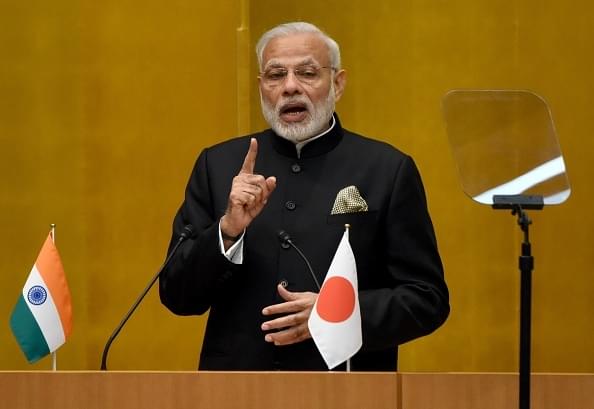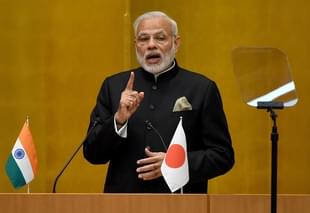Politics
A New Asian Triangle – India, Japan and Myanmar Eyeing A Socio-Economic Partnership
Rajiv Bhatia
Nov 11, 2016, 02:44 PM | Updated 02:44 PM IST
Save & read from anywhere!
Bookmark stories for easy access on any device or the Swarajya app.


On 5 November , Shotaro Yachi, Japan’s national security adviser, met with his Indian counterpart Ajit Doval and S Jaishankar, foreign secretary, to review preparations for Prime Minister Narendra Modi’s visit to Japan this week.
While the Indian media is busy speculating whether the civil nuclear cooperation agreement will be signed during the visit, an important diplomatic angle could be missed. Modi and Japanese Prime Minister Shinzo Abe will have an in-depth exchange of views on regional issues, besides bilateral and global matters. They are unlikely to skip a discussion on Myanmar as its de facto leader, Aung San Suu Kyi, visited both Japan and India recently, with a considerable sense of purpose.
State Counsellor and Foreign Minister Daw Suu Kyi was received not only with full protocol fit for a head of government, but also with much warmth and Japanese generosity. The Abe government announced a special package of grants and loans from public and private sectors amounting to $7.73 billion over a period of five years which Myanmar will use to accelerate its economic development, especially in areas like agriculture, energy, urban development, financial services and human resource development. It will also use the funds to advance the reconciliation process with ethnic minorities.
The Japan-Myanmar partnership is sure to also be based on mutual interests and shared values. Prime Minister Abe expressed “respect” for the nation-building being carried out by the Suu Kyi government, based on “the universal values we share – freedom, democracy, human rights and the rule of law”. The visiting leader reciprocated, voicing her confidence that as Myanmar proceeded “to carve a new page” in its history, Japan would work side by side with it as “a good friend and trustworthy partner”. Japanese officials view Myanmar as “the final frontier within ASEAN”.
Suu Kyi’s visit to Japan also assumes significance because, although the ‘C’ word did not figure in public discourse relating to the visit, China, the Asian giant, continues to shape the diplomatic calculus of Japan and Myanmar. For reasons of strategy, history and sentiment, Japan desires a close partnership with Myanmar, which, in turn, sees in Japan a (partial) counterweight to China.
Suu Kyi’s “independent and non-aligned foreign policy” rides on the wheels of an omni-directional diplomacy: friendship with all but hostility to none, blended with a keen instinct for crafting a fine balance in the whole set of external relationships. Suu Kyi was “trying to get along with both China and Japan at the same time”, wrote Noriyuki Osada, a Japanese scholar.[1]
Barely a fortnight prior to the Japan visit, Suu Kyi was in India both to participate in the BRICS-BIMSTEC outreach summit and also to hold a high-level bilateral dialogue with Indian leaders. Significantly, hers was a state visit; she stayed at Rashtrapati Bhavan as the guest of President Pranab Mukherjee. Hailing her as “an iconic leader”, PrimeMinister Modi depicted Myanmar’s new journey under her “able leadership” as “a journey of hope and promise.” India, he stressed, “will stand with you in full support and solidarity”.
Discussions in Delhi seemed to have added further warmth to the relationship, with the Myanmar leader indicating that her unhappiness with India over maintaining cordial ties with the military government had ended. Ever pragmatic and in power since April 2016, she now faces new challenges, including a critical one: how to leverage cooperation with Asian partners to advance her national priorities – peace, reconciliation and development, but without becoming too dependent on China, in particular.
It is against this backdrop that senior Japanese diplomats and Indian officials in Delhi may be contemplating how Japan and India could harmonise their efforts to cooperate with Myanmar. Their endeavours, whether individually or jointly, will have to be focused on Myanmar’s priorities.
Unlike China, neither country can assist the Myanmar government directly in its mission to bring about progress in dialogue and reconciliation with ethnic minorities, but each can extend moral and political support, arrange intelligence-sharing and offer limited financial assistance. Where, however, Japan and India can cooperate considerably is to assist Myanmar in the field of socio-economic development, an area where several possibilities beckon.
The 6,200-acre Thilawa Special Economic Zone, fully backed by Japan, offers potentially profitable prospects for Indian companies. About 300 Japanese companies have been operational in Myanmar as a whole. India Inc. should explore possibilities of joint ventures and sub-contracting with some of them.
The railway sector should be a special priority amidst reports that China has been pushing hard its project concepts and technology with Naypyitaw. Also, the Indian authorities have been struggling to complete their flagship projects, the Kaladan Multi-Modal Transport and Trilateral Highway. Were Japan to offer its technical and financial assistance, the time for completion of the two much delayed projects could be reduced. Finally, the Japanese government should extend assistance to enhance institutional and people-to-people connectivity between India’s Northeast region and western Myanmar.
Senior Japanese and Indian officials, if not their prime ministers, may be able to compare notes on these possibilities on the sidelines of the India-Japan Summit in Tokyo on November 11-12. Their efforts to forge an informal partnership with Myanmar, restricted to economic cooperation, would have political sensitivity of an acceptable kind as far as the Chinese are concerned. Thus, a new Asian triangle, comprising India, Japan, and Myanmar (IJM), may be in the making.
Myanmar was very close to China under military rule till early 2011. During the five years since then, President Thein Sein strove to chart an independent path, one anchored in the opening towards the West and Asian partners – India and Japan. Aung San Suu Kyi’s Myanmar is taking the same path – but with a determination to cooperate with China as well as others. By deepening their economic cooperation with Myanmar, India and Japan, working together, can help it significantly to safeguard its independent and balanced foreign policy.
References
Yoshida, Reiji, ‘Suu Kyi may overlook qualms with Japan, give firms chance to move in: experts’, The Japan Times, 30 October 2016, (accessed on 7 November 2016).
This article was first published by Gateway House: Indian Council on Global Relations. You can read the original article here.
Rajiv Bhatia is Distinguished Fellow, Foreign Policy Studies Programme, Gateway House, a former high commissioner to South Africa, and a regular commentator on international affairs.





